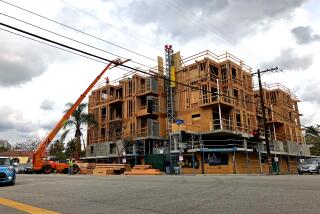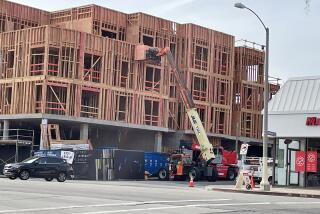Planners OK Zoning Law Limiting City Population
- Share via
A zoning ordinance that would effectively limit the population of Los Angeles to about 4 million, less than half that permitted under existing laws, has been approved by the city Planning Commission after hundreds of hours of preparation and two days of public hearings.
Under pressure from a pending civil lawsuit, the commission unanimously approved the ordinance Thursday, even as city planners worked to prepare extensive maps showing how it would scale down construction throughout the city. The measure now goes to the City Council, where it is expected to be adopted in coming weeks.
The complex ordinance, drafted to comply with a 1979 state zoning law, would prohibit new buildings from exceeding heights or densities established by a series of area community development plans already adopted by the City Council.
Permanent Effect Seen
The measure is expected to permanently affect development throughout the city, where current zoning would allow a population of up to 10 million. The population now is slightly more than 3 million.
“The sun has set on prior . . . zoning,” commission President Daniel Garcia told a hearing room packed with about 100 developers and homeowners.
H. Randall Stoke, an attorney representing developers throughout the city, said the ordinance would block an untold number of building projects and would significantly reduce the size of others.
“Office buildings, other projects have been completely killed. It wipes out a lot of projects and development in the city,” Stoke said.
Planners said the measure is expected to affect about 200,000 private properties, including many extensively affected areas of Hollywood, Venice, the Wilshire district, Wilmington, Harbor Gateway, Silver Lake and surrounding areas. It would also affect lesser areas of Westwood and the San Fernando Valley, planner Dan Green said.
Many Inconsistencies
In some of those areas, Green said, as much as 80% or 90% of the zoning regulations are inconsistent with community plans. Existing zoning laws may permit apartment construction, for example, in neighborhoods that are now occupied by single-family homes. The ordinance would block apartment construction if the community plans call for those neighborhoods to remain zoned for single-family homes.
Planners have been drafting the ordinance hurriedly in the wake of a lawsuit filed in December by the Federation of Hillside and Canyon Associations, a coalition representing a number of homeowners’ groups in the Westside and the San Fernando Valley. Carole Stevens, the organization’s president, said the suit was filed because of the city’s slowness in complying with a 1979 state law that required zoning laws and community plans to conform.
In only a few of the city’s 35 community-plan areas--San Pedro and Pacific Palisades, for example--do the zoning laws already conform to the plans. In other areas, Stevens said, homeowners watched high-density developments being permitted in spite of community-plan recommendations and escalating traffic problems.
Judge’s Ruling
On Jan. 14, Los Angeles Superior Court Judge John L. Cole ordered the city to make its zoning conform to the state law within 120 days, but he stopped short of imposing an interim moratorium on building permits--a moratorium he reserved the right to issue at any time. He said he would extend the deadline if necessary but expected a “good faith” effort by the city to complete the actions.
The city Planning Department, which already has spent more than $1 million trying to make the city’s more than 450 square miles conform to its community plans, is expecting to devote nearly all of its manpower to implementing the ordinance during the coming months, Planning Director Calvin Hamilton said.
Unless the ordinance is altered by the City Council, approval would be retroactive to Thursday’s commission meeting. Commissioners voted for the retroactive approval to prevent additional higher-density projects from beating a later deadline, despite the protests of developers who argued that the ordinance should take effect only after its adoption by the council.
Many developers contested particular provisions of the plan but seemed resigned to its passage.
More to Read
Sign up for Essential California
The most important California stories and recommendations in your inbox every morning.
You may occasionally receive promotional content from the Los Angeles Times.









